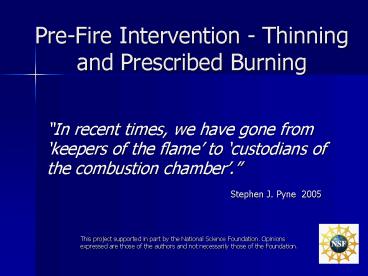PreFire Intervention Thinning and Prescribed Burning - PowerPoint PPT Presentation
1 / 40
Title: PreFire Intervention Thinning and Prescribed Burning
1
Pre-Fire Intervention - Thinning and Prescribed
Burning
- In recent times, we have gone from keepers of
the flame to custodians of the combustion
chamber. - Stephen J. Pyne 2005
This project supported in part by the National
Science Foundation. Opinions expressed are those
of the authors and not necessarily those of the
Foundation.
2
Fire exclusion has dominated wildfire policy
NCSR
3
USDA Forest Service, Tahoe National Forest
4
Predicted Fire Behavior in Treated vs. Untreated
Areas
USDA Forest Service
5
USDA Forest Service, Rocky Mountain Research
Station
6
..the baseline reference condition of forest
stand conditions that evolved from regularly
occurring, low intensity surface burning.
USDA Forest Service 2000
USDA Forest Service Rocky Mountain Research
Station
7
Northwesterly view showing cleanup operations on
the Lick Creek timber sale. USDA Forest
Service 1983
USDA Forest Service Rocky Mountain Research
Station
8
Historical conditions immediately before partial
timber harvest
USDA Forest Service Rocky Mountain Research
Station
9
Overgrown stand
USDA Forest Service
10
Current Situation Many Acres of Overgrown Forest
With Significant Wildfire Hazard
USDA Forest Service
11
- Re-introducing fire wont solve all the
- problems. It is not an ecological pixie
- dust that you can sprinkle over a forest
- and the threat is gone. That would be
- like dropping wolves into a Denver
- mall.
- Stephen J. Pyne
- Arizona State University
12
USDA Forest Service
13
Biscuit Fire SW Oregon 2002
- Post-fire assessment
- of three treatments
- Thinned and under-burned
- Thinning only
- Untreated
Keith Lannom, USDA Forest Service
14
Aftermath of a High Intensity Fire
Effect of Thinning and Prescribed Burning on
Fire Severity in Ponderosa Pine Forests(Pollet
and Omi 2002 )
15
Effects of Fuel Treatments on Fire
SeverityHayman Fire, Colorado
16
Wildfire Management in the Wildland-Urban
Interface (WUI)
USDA Forest Service Tahoe National Forest
17
- Insert map of angora fire
Governors Office of Emergency Services -
California
18
Steve Wilhelm
19
(No Transcript)
20
USDA Forest Service Tahoe National Forest
21
State of California Emergency Services
22
Angora Fire Fuel Treatments
- Untreated Stands (1366 acres)
- Dense, multistoried stands with abundant ladder
fuels - Treated Stands (480 acres)
- Less dense stands with fewer small trees,
dominated - by large Jeffery pines
23
SOS Forests
24
Angora Fire Fuel treatment effectiveness
Treated areas 84 burned with surface fire, 16
burned as crown fire
Untreated areas Most burned as crown fire,
consuming 95-100 of tree crowns and surface
vegetation
USDA Forest Service Tahoe National Forest
25
A New Strategy for Reducing Wildfire Effects
USDA Forest Service Tahoe National Forest
26
What conditions optimize the effectiveness of
mechanical thinning?
- Select forests that are too dense to re-introduce
fire. - Emphasize those forest types that are
characterized by high frequency, low severity
fires. - Conduct thinning as one step in a broader
ecological restoration. - Concentrate on those areas where risk is
greatest. - Assure that markets are available for small
diameter trees.
27
Prescribed Fire
- Fire is the embodiment of
uncertainty, and playing with it is just
what Mama said. - William deBuys 2004
State of Oregon Governors office
28
Expected Outcomes of Prescribed Fire
- Reduction in quantity and continuity of fuels
- Reduction in surface fire intensity
- Reduction in damage to tree crowns
- Ecological effects (i.e., improved fertility,
increased germination of fire-dependent species,
increased biological diversity)
29
Definitions
- Prescribed fire a fire that is intentionally
set to meet management objectives - Prescribed natural fire a lightning-caused fire
that is allowed to burn to meet management
objectives
30
Cerro Grande Fire New Mexico 2000
NASA Earth Observatory
31
NASA Earth Observatory
32
Prescribed Burning
USDA Forest Service Tahoe National Forest
33
Plantation Thinning and Prescribed Burning
USDA Forest Service Tahoe National Forest
34
What conditions optimize the effectiveness of
prescribed burning?
- Forests have moderate to low tree densities and
ladder fuels - Prescribed burning is conducted in the context of
a broader ecological restoration - Slopes are too steep for mechanical thinning
- Adequate funding and knowledgeable personnel are
available - Air quality concerns are addressed
- Appropriate timing
35
The Effects of Vegetation Management
USDA Forest Service Tahoe National Forest
36
The National Fire Plan
- Developed to effectively respond to
- severe wildland fires and their impacts
- to communities
- Increased firefighting capacity
- Rehabilitation
- Hazardous fuels reduction
- Community assistance
37
The Healthy Forests Restoration Act
- Promotes forest thinning as a way to reduce
- the probability of catastrophic wildfire
- Benefits
- Restores overstocked young stands to more
appropriate densities - Reduces "fuels" in young stands
- Reduces fire probability in areas of human
structures - Allows timber sales on public lands
- Boosts local economies
38
The Healthy Forests Restoration Act
- Concerns
- Will mature and old growth forests be
"off-limits"? - Is it economically feasible?
- Will thinning be emphasized near human
structures? - Does thinning reduce the probability of
catastrophic fire? - Areas of Agreement
- Both economic and non-economic values of
overstocked young stands will likely increase in
response to thinning. - Thinning near human structures should be
emphasized. - Old growth resources on public lands should be
protected.
39
Summary
- Thinning and prescribed fire are useful
tools in the reduction of wildfire
impacts. - Effectiveness varies with forest type
and conditions. - Role in ecological restoration
requires additional research.
USDA Forest Service
40
Photo Credits
- Chronicle Lance Iverson
- Governors Office of Emergency Services
California www.oes.ca.gov - NASA Earth Observatory
- SOS Forests www.sosforests.com
- State of California Emergency Service
www.hazardmitigation.oes.ca.gov - Steve Wilhelm www.flickr.com
- USDA Forest Service
- Tahoe National Forest
- Rocky Mountain Research Station
- Keith Lannom































